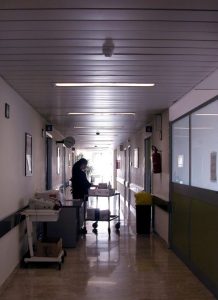A wage-and-hour lawsuit filed in Texas by a nurse at a large hospital alleges the health system docks the pay of nurses each shift for 30 minutes, but they aren’t actually allowed a 30-minute meal break. Instead, nurses are expected to remain on duty for the duration of their shift. 
According to the Houston Chronicle, plaintiff is seeking class-action status for her and 4,000 other nurses who she says should be paid for the time they spend with patients on “phantom” lunch breaks. The lawsuit was filed in a federal court in Houston. Plaintiff asserts the hospital system’s payroll program automatically takes out 30 minutes for meal periods every shift, even though nurses don’t actually get 30 minutes uninterrupted in any given shift. Instead, nurses have to be available the entire shift to care for and attend to patients.
In California, the Department of Industrial Relations holds that companies can’t force an employee to work more than five hours in a given day without providing the worker meal breaks of at least 30 minutes. The only exception is if the worker’s entire work day is no more than six hours. In that case, the meal break can be waived – but only if both the employer and employee mutually consent to it. Further, workers are entitled to a second, 30-minute meal break after 10 hours, except if the employee is going to be working no more than 12 hours and there is mutual consent from both employee and company. (Some variations exist within the motion picture industry.)
Per IWC Orders 1-15, Section 11, Order 16, workers have to be relieved of all duty during this 30-minute meal break, or else the meal period is considered “on duty,” which means it is counted as hours worked, and it’s compensated as hours worked at the employee’s regular pay rate. These type of “on duty meal periods” are only allowed in cases where the nature of the work prevents a worker from being relieved of all duty AND when there is a written agreement between the employee and employer about this fact. Some examples of workers who might have this type of arrangement include:
- Doctors/ nurses/ health care professionals
- Police officers/ firefighters/ first responders
- Sole workers (i.e., all-night convenience store, coffee kiosk, etc.)
- A security guard in a stand-alone station or remote site.
In cases where the employer requires the worker to stay on site or at the facility during the meal break, the meal break has to be paid. Per the 1995 California appellate case of Bono Enterprises Inc. v. Bradshaw, this rule is true even when workers are relieved of all other duties for the duration of their meal break.
Back to the Texas case, a spokeswoman for the hospital insisted the health system is committed to complying with all employment laws, but wouldn’t comment on the specifics of the allegations.
Plaintiff said that while workers are required to clock in and clock out at the beginning and end of their shift, they are not required to clock out for meal breaks. Instead, the payroll system simply deducts 30 minutes from each worker’s shift. An employment attorney representing plaintiff said that while workers have the option of asking to be paid for their lunch break on a day-to-day basis, management discourages them from doing so.
Contact the employment attorneys at Nassiri Law Group, practicing in Orange County, Riverside and Los Angeles. Call 949.375.4734.
Additional Resources:
“Phantom” meal breaks keep nurses on job yet with no pay, June 28, 2016, By L.M. Sixel, Houston Chronicle
More Blog Entries:
Amazon Wage Lawsuit Alleges Joint Employer Status With Trucking Companies, Dec. 2, 2016, L.A. Wage and Hour Lawsuit
 Orange County Employment Lawyers Blog
Orange County Employment Lawyers Blog

